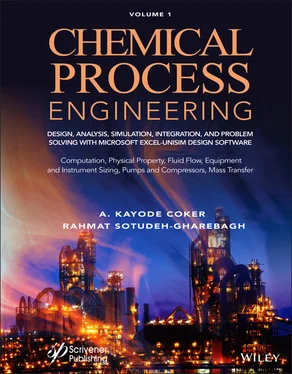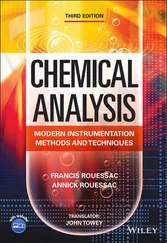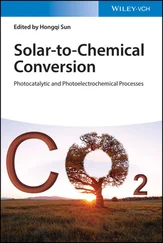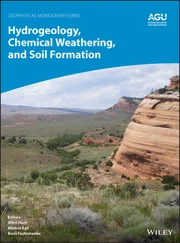A. Kayode Coker - Chemical Process Engineering Volume 1
Здесь есть возможность читать онлайн «A. Kayode Coker - Chemical Process Engineering Volume 1» — ознакомительный отрывок электронной книги совершенно бесплатно, а после прочтения отрывка купить полную версию. В некоторых случаях можно слушать аудио, скачать через торрент в формате fb2 и присутствует краткое содержание. Жанр: unrecognised, на английском языке. Описание произведения, (предисловие) а так же отзывы посетителей доступны на портале библиотеки ЛибКат.
- Название:Chemical Process Engineering Volume 1
- Автор:
- Жанр:
- Год:неизвестен
- ISBN:нет данных
- Рейтинг книги:3 / 5. Голосов: 1
-
Избранное:Добавить в избранное
- Отзывы:
-
Ваша оценка:
- 60
- 1
- 2
- 3
- 4
- 5
Chemical Process Engineering Volume 1: краткое содержание, описание и аннотация
Предлагаем к чтению аннотацию, описание, краткое содержание или предисловие (зависит от того, что написал сам автор книги «Chemical Process Engineering Volume 1»). Если вы не нашли необходимую информацию о книге — напишите в комментариях, мы постараемся отыскать её.
Chemical Process Engineering Volume 1 — читать онлайн ознакомительный отрывок
Ниже представлен текст книги, разбитый по страницам. Система сохранения места последней прочитанной страницы, позволяет с удобством читать онлайн бесплатно книгу «Chemical Process Engineering Volume 1», без необходимости каждый раз заново искать на чём Вы остановились. Поставьте закладку, и сможете в любой момент перейти на страницу, на которой закончили чтение.
Интервал:
Закладка:
The process design concepts, guidelines; codes and standards are clearly important, and several excellent books and references are available to address these issues and will be cited in the book where applicable. However, these two volume-sets are unique in that to date no textbook on chemical process design and simulation has been published, which provides adequate information (theory, equations, figures, tables and programs) to enable the reader to perform robust calculations using Excel spreadsheet - UniSim Design software program. The better use of these tools in the special format shapes the core of the book as:
– Microsoft Excel® is part of the Microsoft Office. It is widely recognized as the most versatile spreadsheet for problem solving, which enables a chemical engineer to make computation and visualizations in an easiest way possible. Process engineers can use Excel spreadsheet for equipment and process design, modeling, simulation and optimization. Data bases and pivot tables can be easily designed with Excel spreadsheet to ease making calculations, understanding technical reports, and preparing charts and figures.
– The new improved UniSim R480 Design of Honeywell, is a smart and intuitive software; it creates thermodynamics and unit operation steady-state and dynamic models. Process simulation is a tool used to design a new process, an existing process or debottleneck, monitor process conditions, troubleshoot current operations to compare theoretical results, optimize process conditions for enhanced throughput, and to reduce energy yields, and emissions.
The contents of this book have been formed over many years through the concentrated research and industrial efforts of the authors. Furthermore, to assist the user and to demonstrate the validity of the methods, worked examples and case studies of practical relevance using the Excel spreadsheet and UniSim Design software programs are provided throughout the text, and the source files are provided at the publisher website. In this way, the students, and engineers can save time by using hands-on tools to ease the calculation and concentrate in understanding the fundamentals of the phenomena occurring in the process design sequences. These two volumes are fully extended version of the original title: Fortran Programs for Chemical Process Design, Analysis and Simulation by A. Kayode Coker. In these volumes, we have provided examples in both Imperial and SI units, but we have intentionally kept most examples in Imperial units based on the following reasons:
1 a) All problems solved in UniSim Design can be easily converted to any units of measurement and it makes no difference which unit is used.
2 b) The use of both units is very useful from instructional viewpoint as students need to have some sort of practice with both units as the Imperial unit is still used in some countries.
However, since all problems are carefully solved in Excel, the conversion is then easy, and we have also provided a conversion table to assist readers in their calculations.
The book is primarily intended to serve senior students, early career engineers, university professors and practitioners, especially in the process, chemical, petrochemical, biochemical, mechanical, mining and metallurgical industries. However, other engineers, consultants, technicians and scientists concerned with various aspects of industrial design, and scale-up may also find it useful. It can be considered as a textbook to process design for senior and graduate students as well as a hands-on document for engineers at the entry level and practitioners. The content of this book can also be taught in intensive workshops in process industries.
Acknowledgments
RSG wishes to express his profound gratitude to his students for reading the chapters and checking the programs. Further, he wishes to thank his current and former graduate students, Ms. Aghasi, Ms. Bakhshi and Messrs. Jabbari, Ahmadi, Moshiri, Khodabendehlou for checking the chapters and programs. Special credits are also extended to Professor Jamal Chaouki from Polytechnique de Montreal for hosting RSG for his sabbatical leave upon the completion of the book beside the main activity planned for sababtical. AKC expresses his gratitude to Ahmed Mutawa, formerly of SASREF for developing the conversion table software for the book. Thank you, Ahmed.
Wherever it is required, permissions have been obtained to reproduce the works published by some organizations and companies. We acknowledge and thank the American Institute of Chemical Engineers, the Institution of Chemical Engineers (U.K.), Chemical Engineering (Mc-Graw Hill), Oil & Gas Journal, Tubular Exchanger Manufacturers’ Association, American Petroleum Institute, John Wiley & Sons, Nutter Engineering, and many other organizations that provided materials for this book. We express our gratitude to Honeywell Process Solutions for granting permission to incorporate the use of UniSim Design software simulation and many suites of software programs in the book.
We wish to express our thanks to the Wiley-Scrivener team: Kris Hackerott- Graphics Designer, Bryan Aubrey – Copy editor, Myrna Ting – Typesetter and her colleagues. We are truly grateful for your professionalism, assistance and help in the production of this volume. Finally, very special thanks to Phil Carmical of Scrivener publishing company for his advice and helpful suggestions during the production of this volume.
Finally, we should emphasize that process design is a creative, dynamic and challenging activity and for this reason, the design books like this one need continuous improvement with current digitalization outlook and abundant access to computation resources. We would appreciate and welcome any comments, suggestions, or feedback that you may have on this volume.
A. Kayode Coker (www.akctechnology.com)
A. K.C. TECHNOLOGY, U.K.
Rahmat Sotudeh-Gharebagh (sotudeh@ut.ac.ir) College of Engineering, University of Tehran, Iran
About the Authors
A. Kayode Coker PhD, is Engineering Consultant for AKC Technology, an Honorary Research Fellow at the University of Wolverhampton, U.K., a former Engineering Coordinator at Saudi Aramco Shell Refinery Company (SASREF) and Chairman of the Department of Chemical Engineering Technology at Jubail Industrial College, Saudi Arabia. He has been a chartered chemical engineer for more than 30 years. He is a Fellow of the Institution of Chemical Engineers, U.K., and a senior member of the American Institute of Chemical Engineers. He holds a B.Sc. honors degree in Chemical Engineering, a Master of Science degree in Process Analysis and Development and Ph.D. in Chemical Engineering, all from Aston University, Birmingham, U.K., and a Teacher’s Certificate in Education at the University of London, U.K., He has directed and conducted short courses throughout the world and has been a lecturer at the university level. His articles have been published in several international journals. He is an author of seven books in chemical engineering, a contributor to the Encylopedia of Chemical Processing and Design, Vol. 61, and a certified train – the mentor trainer. He is a Technical Report Assessor and Interviewer for chartered chemical engineers (IChemE) in the U.K. He is a member of the International Biographical Centre in Cambridge, U.K. (IBC) as Leading Engineers of the World for 2008. Also, he is a member of International Who’s Who for Professionals™ and Marquis Who’s Who in the U.S.
Rahmat Sotudeh-Gharebaghis currently a full Professor of Chemical Engineering at the University of Tehran (P.O. Box 11155–4563, Iran; email: sotudeh@ut.ac.ir). He teaches process modeling and simulation, transport phenomena and fluidization, plant design and economics and soft skills. His research interests include computer-aided process design and simulation, fluidization, and engineering education. He holds a B.Eng. degree in chemical engineering from Iran’s Sharif University of Technology, plus a M.Sc. and a Ph.D. in Fluidization Engineering from Canada’s Polytechnique. He has been an invited Professor at Qatar University and Polytechnique de Montréal. Professor Sotudeh has more than 300 publications in major international journals and conferences, plus six books and four book chapters. He is the co-founder and Editor-in-Chief of Chemical Product and Process Modeling published by Walter de Gruyter GmbH, Germany, a Member of the Iranian Elite Foundation and an Expert Witness on the oil industry with the Iranian Expert Witness Organization and a winner of various awards and prizes.
Читать дальшеИнтервал:
Закладка:
Похожие книги на «Chemical Process Engineering Volume 1»
Представляем Вашему вниманию похожие книги на «Chemical Process Engineering Volume 1» списком для выбора. Мы отобрали схожую по названию и смыслу литературу в надежде предоставить читателям больше вариантов отыскать новые, интересные, ещё непрочитанные произведения.
Обсуждение, отзывы о книге «Chemical Process Engineering Volume 1» и просто собственные мнения читателей. Оставьте ваши комментарии, напишите, что Вы думаете о произведении, его смысле или главных героях. Укажите что конкретно понравилось, а что нет, и почему Вы так считаете.




![Евгений Матерёв - Музеи… или вдохновляющая музыка The Chemical Brothers [litres самиздат]](/books/437288/evgenij-materev-muzei-ili-vdohnovlyayuchaya-muzyka-th-thumb.webp)







